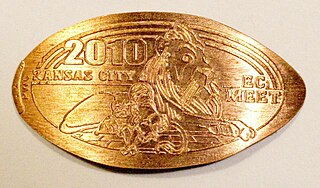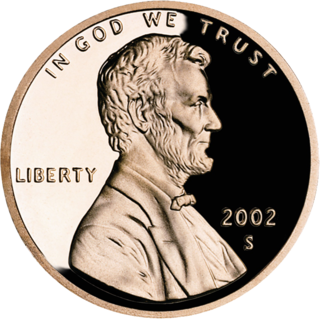Related Research Articles
Coins of the United States dollar – aside from those of the earlier Continental currency – were first minted in 1792. New coins have been produced annually and they comprise a significant aspect of the United States currency system. Circulating coins exist in denominations of 1¢, 5¢, 10¢, 25¢, 50¢, and $1.00. Also minted are bullion, including gold, silver and platinum, and commemorative coins. All of these are produced by the United States Mint. The coins are then sold to Federal Reserve Banks which in turn put coins into circulation and withdraw them as demanded by the United States economy.
There are eight euro coin denominations, ranging from one cent to two euro. The coins first came into use in 2002. They have a common reverse, portraying a map of Europe, but each country in the eurozone has its own design on the obverse, which means that each coin has a variety of different designs in circulation at once. Four European microstates that are not members of the European Union use the euro as their currency and also have the right to mint coins with their own designs on the obverse side.

The Canadian dollar is the currency of Canada. It is abbreviated with the dollar sign $. There is no standard disambiguating form, but the abbreviations Can$, CA$ and C$ are frequently used for distinction from other dollar-denominated currencies. It is divided into 100 cents (¢).

A penny is a coin or a unit of currency in various countries. Borrowed from the Carolingian denarius, it is usually the smallest denomination within a currency system. At present, it is the formal name of the British penny (abbr. p) and the de facto name of the American one-cent coin (abbr. ¢) as well as the informal Irish designation of the 1 euro cent coin (abbr. c). Due to inflation, pennies have lost virtually all their purchasing power and are often viewed as an expensive burden to merchants, banks, government mints and the public in general.

The penny, also known as the cent, is a coin in the United States representing one-hundredth of a dollar. It has been the lowest face-value physical unit of U.S. currency since the abolition of the half-cent in 1857.

1943 steel cents are U.S. one-cent coins that were struck in steel due to wartime shortages of copper. The Philadelphia, Denver, and San Francisco mints each produced these 1943 Lincoln cents. The unique composition of the coin has led to various nicknames, such as wartime cent, steel war penny, zinc cent and steelie. The 1943 steel cent features the same Victor David Brenner design for the Lincoln cent which had been in use since 1909.
Mint-made errors occur when coins are made incorrectly at the mint, including anything that happens to the coin up until the completion of the minting process. Mint error coins can be the result of deterioration of the minting equipment, accidents or malfunctions during the minting process, or interventions by mint personnel. Coins are inspected during production and errors are typically caught. However, some are inadvertently released into circulation. Modern production methods eliminate many errors and automated counters are effective at removing error coins. Damage occurring later may sometime resemble true mint errors. Error coins may be of value to collectors depending on the rarity and condition. Some coin collectors specialize in error coins.

A nickel is a five-cent coin struck by the United States Mint. Composed of cupronickel, the piece has been issued since 1866. Its diameter is 0.835 inches (21.21 mm) and its thickness is 0.077 inches (1.95 mm).

A mint is an industrial facility which manufactures coins that can be used as currency.

An elongated coin is a coin that has been flattened or stretched, and embossed with a new design. Such coins are often used as commemorative or souvenir tokens, and it is common to find coin elongation machines in tourism hubs, such as museums, amusement parks, and natural or man-made landmarks.

In Canada, a penny is an out-of-production coin worth one cent, or 1⁄100 of a dollar. According to the Royal Canadian Mint, the official term for the coin is the one-cent piece, but in practice the terms penny and cent predominate. Penny was likely readily adopted because the previous coinage in Canada was the British monetary system, where Canada used British pounds, shillings, and pence as coinage alongside U.S. decimal coins. Like all Canadian coins, the obverse depicts the reigning Canadian monarch at the time of issue.
The coins of Canada are produced by the Royal Canadian Mint and denominated in Canadian dollars ($) and the subunit of dollars, cents (¢). An effigy of the reigning monarch always appears on the obverse of all coins. There are standard images which appear on the reverse, but there are also commemorative and numismatic issues with different images on the reverse.

A debate exists within the United States government and American society at large over whether the one-cent coin, the penny, should be eliminated as a unit of currency in the United States. The penny costs more to produce than the one cent it is worth, meaning the seigniorage is negative – the government loses money on every penny that is created. Several bills introduced in the U.S. Congress would have ceased production of pennies, but none have been approved. Such bills would leave the five-cent coin, or nickel, as the lowest-value coin minted in the United States.

The 2 euro cent coin (€0.02) has a value of one-fiftieth of a euro and is composed of copper-plated steel. All euro coins have a common reverse and country-specific (national) obverse. The coin has been used since 2002 and was not redesigned in 2007 as were the higher-value coins.

The 1974 aluminum cent was a one-cent coin proposed by the United States Mint in 1973. It was composed of an alloy of aluminum and trace metals, and it was intended to replace the predominantly copper–zinc cent due to the rising costs of coin production in the traditional bronze alloy. Of the 1,571,167 coins struck in anticipation of release, none were released into circulation. To encourage congressional support for the new alloy, the Mint distributed several examples to U.S. Congressmen. When the proposed aluminum cent was rejected, the Mint recalled and destroyed those coins.
The coins of the New Zealand dollar are used for the smallest physical currency available in New Zealand. The current denominations are ten cents, twenty cents, fifty cents, one dollar and two dollars. The $1 and $2 coins are minted in a gold colour, the 20c and 50c coins are silver colour and the 10c coin is plated in copper.

The Lincoln cent is a one-cent coin that has been struck by the United States Mint since 1909. The obverse or heads side was designed by Victor David Brenner, as was the original reverse, depicting two stalks of wheat. The coin has seen several reverse, or tails, designs and now bears one by Lyndall Bass depicting a Union shield. All coins struck by the United States government with a value of 1⁄100 of a dollar are called cents because the United States has always minted coins using decimals. The penny nickname is a carryover from the coins struck in England, which went to decimals for coins in 1971.

The withdrawal of a country's lowest-denomination coins from circulation may either be through a decision to remove the coins from circulation, or simply through ceasing minting.

The 1909-S VDB Lincoln Cent is a low-mintage coin of the United States dollar. It is a key date variety of the one-cent coin produced by the United States Mint in San Francisco in 1909. The Lincoln penny replaced the Indian Head penny and was the first everyday U.S. coin to feature an actual person, but it was immediately met with controversy over the inclusion of the initials of the sculptor who designed the coin, Victor David Brenner, on the reverse.
References
- ↑ Boye, Roger (29 April 1990). "Americans For Common Cents Calls For Penny-wise Policy". Chicago Tribune. Retrieved 30 October 2014.
- ↑ Mitchell, Dan (11 April 2012). "Don't mess with the penny lobby". Fortune. Retrieved 30 October 2014.
- ↑ Williams, Geoff (14 February 2013). "The American Penny: How It's Stuck Around All These Years". U.S. News & World Report. Retrieved 31 October 2014.
- ↑ Associated Press (9 December 2000). "Economist: The Penny Just Makes 'Cents'". The Victoria Advocate. Retrieved 2 November 2014.
- ↑ Resident Population Data. "Resident Population Data – 2010 Census". www.census.gov. Retrieved February 22, 2013.
- ↑ Brady, Jonann (21 June 2006). "K-Fed Pleads for Pennies". ABC News. Retrieved 30 October 2014.
- ↑ Hagenbaugh, Barbara (6 July 2006). "A penny saved could become a penny spurned". USA Today. Retrieved 30 October 2014.
- ↑ "U.S. Penny to Be Kept as Canada Bids Coin Farewell". ABC News. 30 March 2012. Retrieved 30 October 2014.
- ↑ Weinberg, Ali (19 February 2013). "Penny pinching: Can Obama manage elimination of one-cent coin?". NBC News. Archived from the original on 17 January 2022. Retrieved 13 November 2023.
- ↑ Harper, Jennifer (13 February 2009). "Do pennies still make sense?". Washington Times. Retrieved 31 October 2014.
- ↑ Benjaminson, Wendy (24 May 1990). "Americans Getting Centimental About the Penny". Associated Press. Retrieved 31 October 2014.
- ↑ Ingraham, Christopher (10 March 2014). "Taxpayers lost $105 million on pennies and nickels last year". Washington Post. Retrieved 31 October 2014.